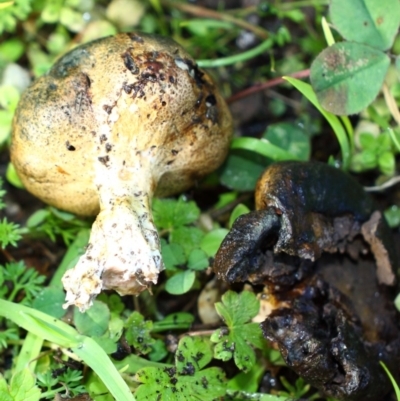Scleroderma sp. (Scleroderma)
Mature Scleroderma fruit bodies hold a mass of powdery spores. Initially the fruit body is more or less globular (perhaps raised on a short, thickish, pseudo-stem), yellow to brown externally, solid, whitish internally. The globular section may be 2 to 8 centimetres in diameter, depending on species. Over time purplish brown spores develop inside and eventually the fruit body consists of a thick skin holding a mass of spores. The thickness of the skin varies, depending on species. Sometimes only about a millimetre thick in others a few millimetres. The thick skin splits irregularly, but more or less radially and in general the sectors then bend out a bit to expose the powdery spore mass for dispersal by wind or water.
In this photo (http://www.cpbr.gov.au/fungi/images-captions/scleroderma-sp-0068.html) you see the insides of two fruit bodies. The one on the left is fairly immature, largely with pale flesh but you can see that mature spores are already present in part of the fruit body. In the one on the right the interior is now wholly spores and you can see the thick skin (about 2-3 mm thick in this case) quite clearly. Splitting of the skin would be about to start. In these two fruit bodies there is no pseudo-stem. In this photo (http://www.cpbr.gov.au/fungi/images-captions/scleroderma-sp-0069.html) you see three mature fruit bodies with varying degrees of splitting and bending outward.
The name Scleroderma is derived from two Greek words skleros (tough) and derma (skin) and, as well as being a fungal genus, the word is also the name of an autoimmune disease in which there is a hardening of the skin.
Scleroderma vs. Calvatia
Calvatia is another genus in which you may find powdery spored, roughly globular fruit bodies in which the outer skin breaks up.
The skin in Calvatia is thin (under a millimetre thick) and it breaks up into irregular fragments which fall away. The best analogy I can make is to say the skin breaks up a bit like flaky pastry. There is not the radial splitting and bending out.
In Calvatia the spores are held within a cotton-wool-like mass (technically a capillitium). There is no capillitium in Scleroderma.
A Calvatia fruit body is softer and more squashable, a bit like a sponge - but this last point of difference is obviously more subjective.
Scleroderma sp. is listed in the following regions:
Canberra & Southern Tablelands | Southern Highlands | Albury, Wodonga | South Coast | Barwon South West
Species information
- Scleroderma sp. Scientific name
- Scleroderma Common name
- Not Sensitive
- Local native
- Non-invasive or negligible
- Up to 909.95m Recorded at altitude
- Machine learning
Location information
-
Maps
ANBG ANBG South Annex ANU Baldessin Precinct Aranda Bushland Australian National University Banksia Street Wetland Corridor Bicentennial Park Black Mountain Blue Range Bluetts Block (402, 403, 12, 11) Bruce Ridge Bruce Ridge to Gossan Hill Cooma North Ridge Reserve Crace Grasslands Denman Prospect 2 Estate Deferred Area (Block 12) Federal Golf Course Googong Foreshore Gossan Hill Goulburn Mulwaree Council Gungaderra Grasslands Hughes Garran Woodland Hughes Grassy Woodland Isaacs Ridge Isaacs Ridge and Nearby Kybeyan State Conservation Area Lake Ginninderra Molonglo Gorge Molonglo River Reserve Mongarlowe River Mount Ainslie Mount Jerrabomberra Mount Jerrabomberra QP Mount Majura Mount Painter Namadgi National Park National Arboretum Forests Piney Ridge Red Hill Nature Reserve Red Hill to Yarralumla Creek Sullivans Creek, Lyneham South The Pinnacle Tidbinbilla Nature Reserve Umbagong District Park Watson Woodlands West Goulburn Bushland Reserve -
Places
Hughes, ACT Watson, ACT
































































































































































































